Effect of Flux Barriers on Short-Circuit Current and Braking Torque in Dual Three-Phase PM Machine
Abstract
:1. Introduction
2. Machine with Different Flux Barriers and Winding Distribution
3. Influence of Stator Flux Barriers on SCC and Braking Torque
3.1. SCC and Braking Torque Calculation
3.2. Magnetic Flux Analysis with Flux Barriers
3.3. Inductance Analysis with Flux Barriers
4. Analysis and Comparison
4.1. Selection of Flux Barrier Width
4.2. Single-Phase Short Circuit Condition
4.3. Three-Phase Short Circuit Condition
5. Experimental Validation
6. Conclusions
- (1)
- The appropriate width of the armature tooth flux barriers can increase the PM flux linkage, but the auxiliary tooth flux barriers will reduce the PM flux linkage. Therefore, compared with TSM, the output torque of SL-ATM is increased by 10.3%, while that of SL-ABM is reduced by 10.8%.
- (2)
- Although stator flux barriers can reduce the harmonic leakage inductance of the machine, they can also increase the slot opening leakage inductance and inter-slot leakage inductance. Therefore, the appropriate flux barrier width can improve the self-induction, thus inhibiting SCC and braking torque. Among them, SL-ABM has the smallest SCC and braking torque, followed by SL-ATM.
- (3)
- After entering the fault-tolerant operation mode of three-phase symmetrical short-circuit, in order to keep the machine working at the rated point, the compensation current required by SL-ATM is the minimum, and that of SL-ABM is the maximum.
Author Contributions
Funding
Data Availability Statement
Conflicts of Interest
References
- Li, J.; Wang, K.; Zhang, H. Flux focusing permanent magnet machines with modular consequent-pole rotor. IEEE Trans. Ind. Electron. 2020, 67, 3374–3385. [Google Scholar] [CrossRef]
- Chakraborty, I.; Mavris, D.N.; Emeneth, M.; Schneegans, A. An integrated approach to vehicle and subsystem sizing and analysis for novel subsystem architectures. Proc. Inst. Mech. Eng. Part G J. Aerosp. 2016, 230, 496–514. [Google Scholar] [CrossRef]
- Sarigiannidis, A.G.; Beniakar, M.E.; Kakosimos, P.E.; Kladas, A.G.; Papini, L.; Gerada, C. Fault tolerant design of fractional slot winding permanent magnet aerospace actuator. IEEE Trans. Ind. Electron. 2016, 2, 380–390. [Google Scholar] [CrossRef]
- Scharlau, C.C.; Pereira, L.F.A.; Pereira, L.F.; Haffner, S. Performance of a five-phase induction machine with optimized air gap field under open loop V/f control. IEEE Trans. Energy Convers. 2008, 23, 1046–1056. [Google Scholar] [CrossRef]
- Zhou, H.W.; Liu, G.H.; Zhao, W.X.; Yu, X.D. Dynamic Performance Improvement of Five-Phase Permanent-Magnet Machine with Short-Circuit Fault. IEEE Trans. Ind. Electron. 2017, 52, 3680–3690. [Google Scholar]
- Rahman, A.A.; Galassini, A.; Degano, M.; Gerada, C.; Bozhko, S.; Almurib, H.A.F. Open and Short Circuit Post-Fault Control Strategies for Multi-Three-Phase Interior Permanent Magnet Machines. IEEE Trans. Energy Convers. 2022, 37, 163–174. [Google Scholar]
- Guo, H.; He, X.; Xu, J.Q.; Tian, W. Design of an Aviation Dual-Three-Phase High-Power High-Speed Permanent Magnet Assisted Synchronous Reluctance Starter-Generator with Antishort-Circuit Ability. IEEE Trans. Power Electron. 2022, 37, 12619–12635. [Google Scholar] [CrossRef]
- Zhu, S.; Zhao, W.; Liu, G.; Mao, Y.; Sun, Y. Effect of phase shift angle on radial force and vibration behavior in dual three-phase PMSM. IEEE Trans. Ind. Electron. 2021, 68, 2988–2998. [Google Scholar] [CrossRef]
- Zheng, J.; Zhao, W.; Ji, J.; Zhu, J.; Lee, C.H.T. Sleeve design of permanent-magnet machine for low rotor losses. Chin. J. Elect. Eng. 2020, 6, 86–96. [Google Scholar] [CrossRef]
- Guo, L.Y.; Xu, J.Q.; Wu, S.; Xie, X.M.; Wang, H.M. Analysis and Design of Dual Three-Phase Fractional-Slot Permanent Magnet Motor with Low Space Harmonic. IEEE Trans. Magn. 2022, 58, 8100112. [Google Scholar] [CrossRef]
- Xu, P.; Feng, J.H.; Guo, S.Y.; Feng, S.; Chu, W.; Ren, Y.; Zhu, Z.Q. Analysis of dual three-phase permanent-magnet synchronous machines with different angle displacements. IEEE Trans. Ind. Electron. 2018, 65, 1941–1954. [Google Scholar] [CrossRef]
- Li, F.; Wang, K.; Zhang, J.; Zeng, F. Effect of angle displacements on electromagnetic performance of dual three-phase consequent-pole permanent magnet machine. IET Electr. Power Appl. 2020, 14, 1177–1185. [Google Scholar] [CrossRef]
- Sun, Y.H.; Zhao, W.X.; Ji, J.H.; Zheng, J.Q. Effect of Phase Shift on Inductance and Short-Circuit Current in Dual Three-Phase 48-Slot/22-Pole Permanent-Magnet Machines. IEEE Trans. Ind. Electron. 2021, 65, 1941–1954. [Google Scholar] [CrossRef]
- Barcaro, M.; Bianchi, N.; Magnussen, F. Analysis and tests of a dual three-phase 12-Slot 10-Pole permanent-magnet machine. IEEE Trans. Ind. Appl. 2010, 46, 2355–2362. [Google Scholar] [CrossRef]
- Barcaro, M.; Bianchi, N.; Magnussen, F. Six-Phase supply feasibility using a PM fractional-slot dual winding machine. In Proceedings of the 2010 IEEE Energy Conversion Congress and Exposition, Atlanta, GA, USA, 12–16 September 2011; Volume 47. [Google Scholar]
- Wang, W.; Zhang, J.H.; Cheng, M.; Li, S.H. Fault-tolerant control of dual three-phase permanent-magnet synchronous machine drives under open-phase faults. IEEE Trans. Power. Electron. 2017, 32, 2052–2063. [Google Scholar] [CrossRef]
- Dajaku, G.; Xie, W.; Gerling, D. Reduction of low space harmonics for the fractional slot concentrated windings using a novel stator design. IEEE Trans. Magn. 2014, 50, 1012–1019. [Google Scholar] [CrossRef]
- Dajaku, G.; Gerling, D. A novel tooth concentrated winding with low space harmonic content. In Proceedings of the 2013 International Electric Machines & Drives Conference, Chicago, IL, USA, 12–15 May 2013; pp. 755–760. [Google Scholar]
- Dajaku, G.; Gerling, D. Eddy current loss minimization in rotor magnets of PM machines using high-efficiency 12-teeth/10-poles winding topology. In Proceedings of the International Conference on Electrical Machines and Systems, Beijing, China, 20–23 August 2011. [Google Scholar]
- Li, G.J.; Zhu, Z.Q.; Foster, M.P.; Stone, D.A.; Zhan, H.L. Modular permanent-magnet machines with alternate teeth having tooth tips. IEEE Trans. Ind. Electron. 2015, 62, 6120–6130. [Google Scholar] [CrossRef] [Green Version]
- Li, G.J.; Zhu, Z.Q.; Chu, W.Q.; Foster, M.P.; Stone, D.A. Influence of flux gaps on electromagnetic performance of novel modular PM machines. IEEE Trans. Magn. 2014, 19, 716–726. [Google Scholar] [CrossRef]
- Li, G.J.; Zhu, Z.Q. Analytical modeling of modular and unequal tooth width surface-mounted permanent magnet machines. IEEE Trans. Magn. 2015, 51, 8107709. [Google Scholar] [CrossRef] [Green Version]
- Liu, Z.Q.; Wang, K.; Sun, H.Y.; Zhou, B. DC-Field excitation variable flux reluctance starter generator with modular structure for fault-tolerant capability improvement. IEEE Trans. Ind. Electron. 2021, 68, 1141–1154. [Google Scholar] [CrossRef]
- Wu, F.; Tong, C.; Sui, Y.; Cheng, L.; Zheng, P. Influence of third harmonic back EMF on modeling and remediation of winding short circuit in a multiphase PM machine with FSCWs. IEEE Trans. Ind. Electron. 2016, 63, 6031–6041. [Google Scholar] [CrossRef]
- Liu, L.; Wang, K.; Zhu, S.S.; Liu, C. Split ratio trade-off between output torque and braking torque of surface-mounted permanent-magnet machines. IET Electr. Power Appl. 2020, 14, 1196–1203. [Google Scholar] [CrossRef]
- Du, K.K.; Xu, L.; Zhao, W.X.; Liu, G.H. Analysis and design of a fault-tolerant permanent magnet vernier machine with improved power factor. IEEE Trans. Ind. Electron. 2021, 58, 1141–1154. [Google Scholar] [CrossRef]
- Chen, Q.; Gu, L.C.; Wang, J.B.; Liu, G.; Zhao, W.X. Remedy strategy for five-phase FTPMMs under single-phase short-circuit fault by injecting harmonic currents from third space. IEEE Trans. Power Electron. 2022, 37, 11152–11163. [Google Scholar] [CrossRef]
- Zhao, W.X.; Du, K.K.; Xu, L. Design considerations of fault-tolerant permanent magnet vernier machine. IEEE Trans. Ind. Electron. 2020, 67, 7290–7300. [Google Scholar] [CrossRef]
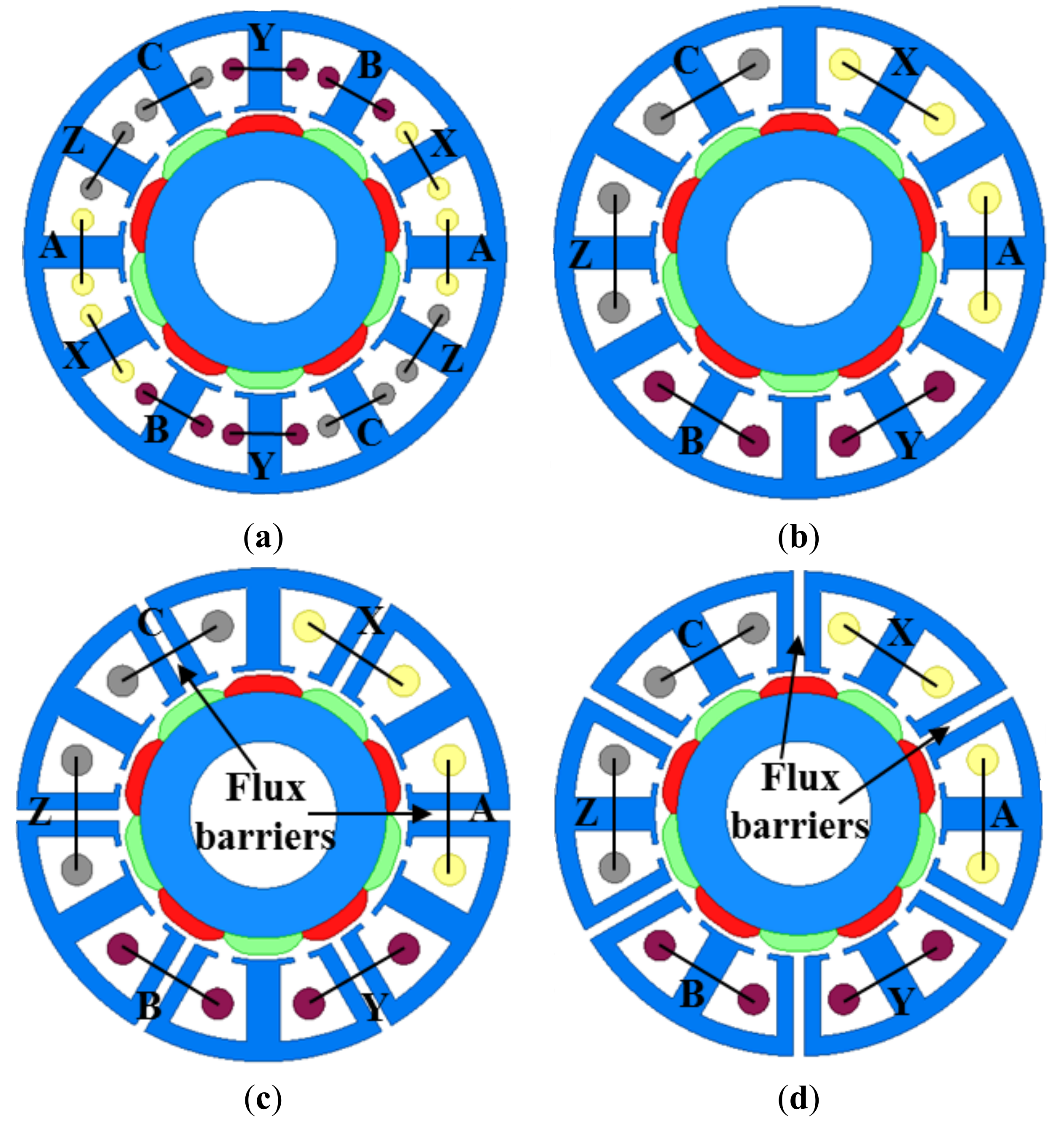

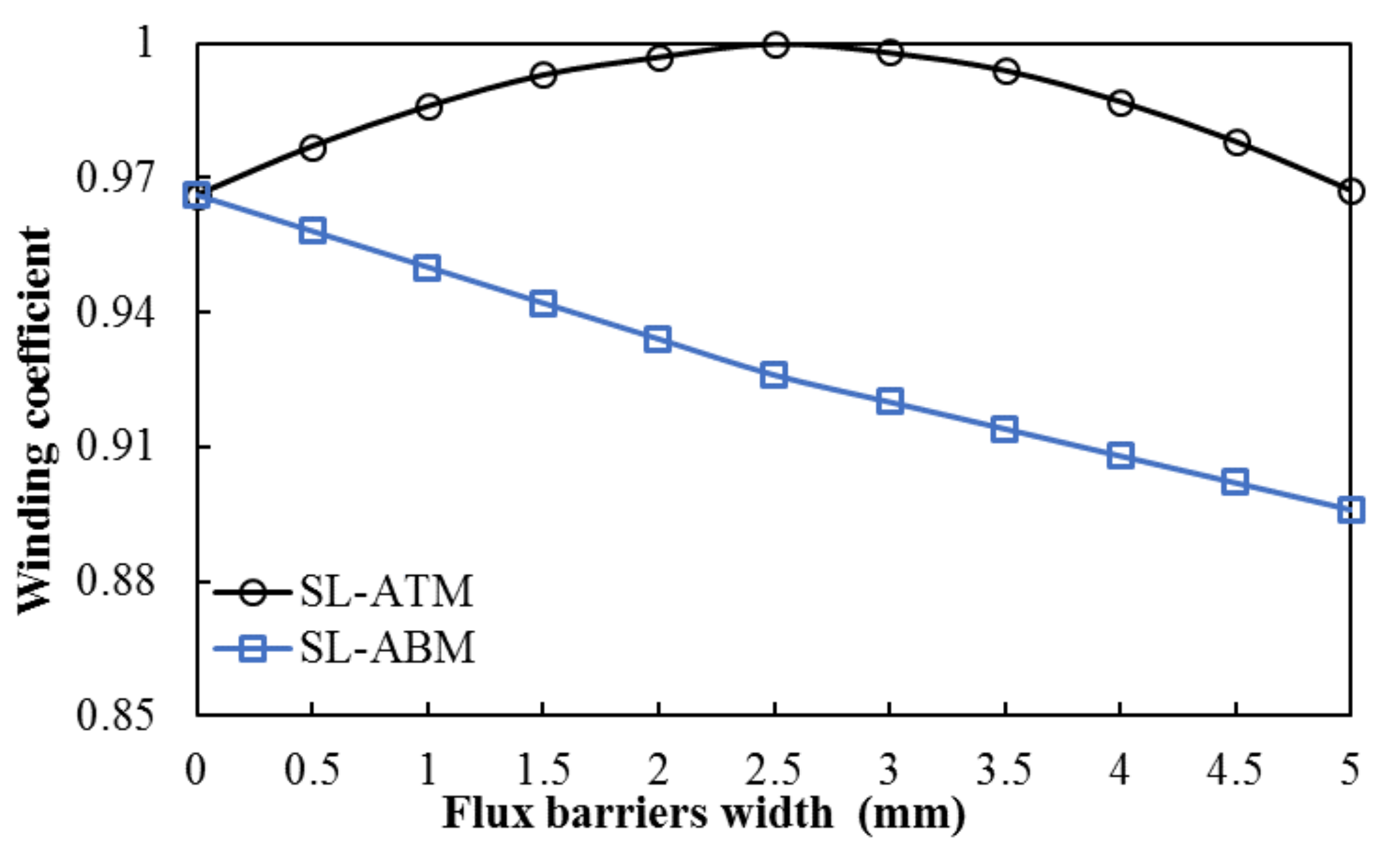
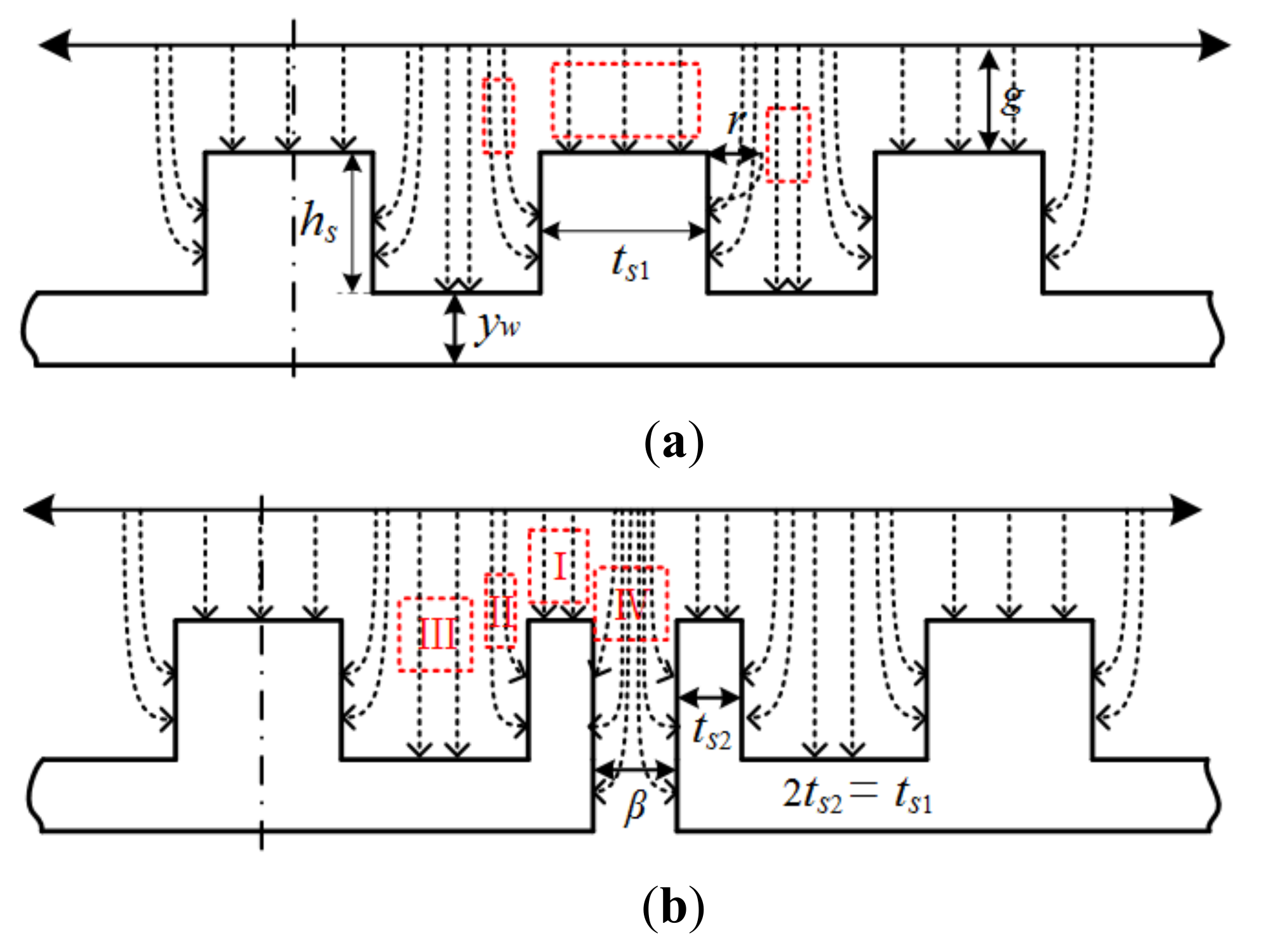

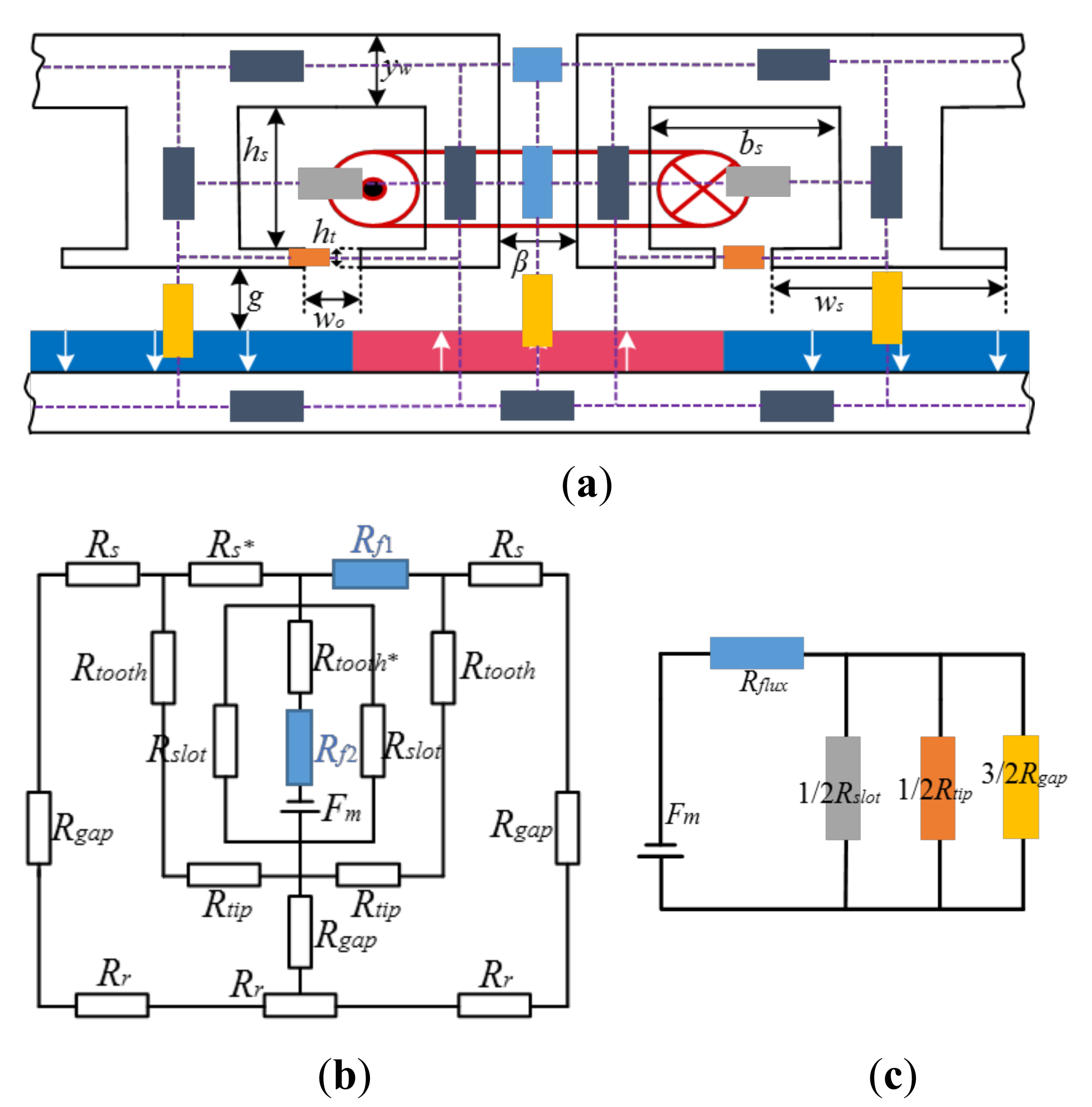
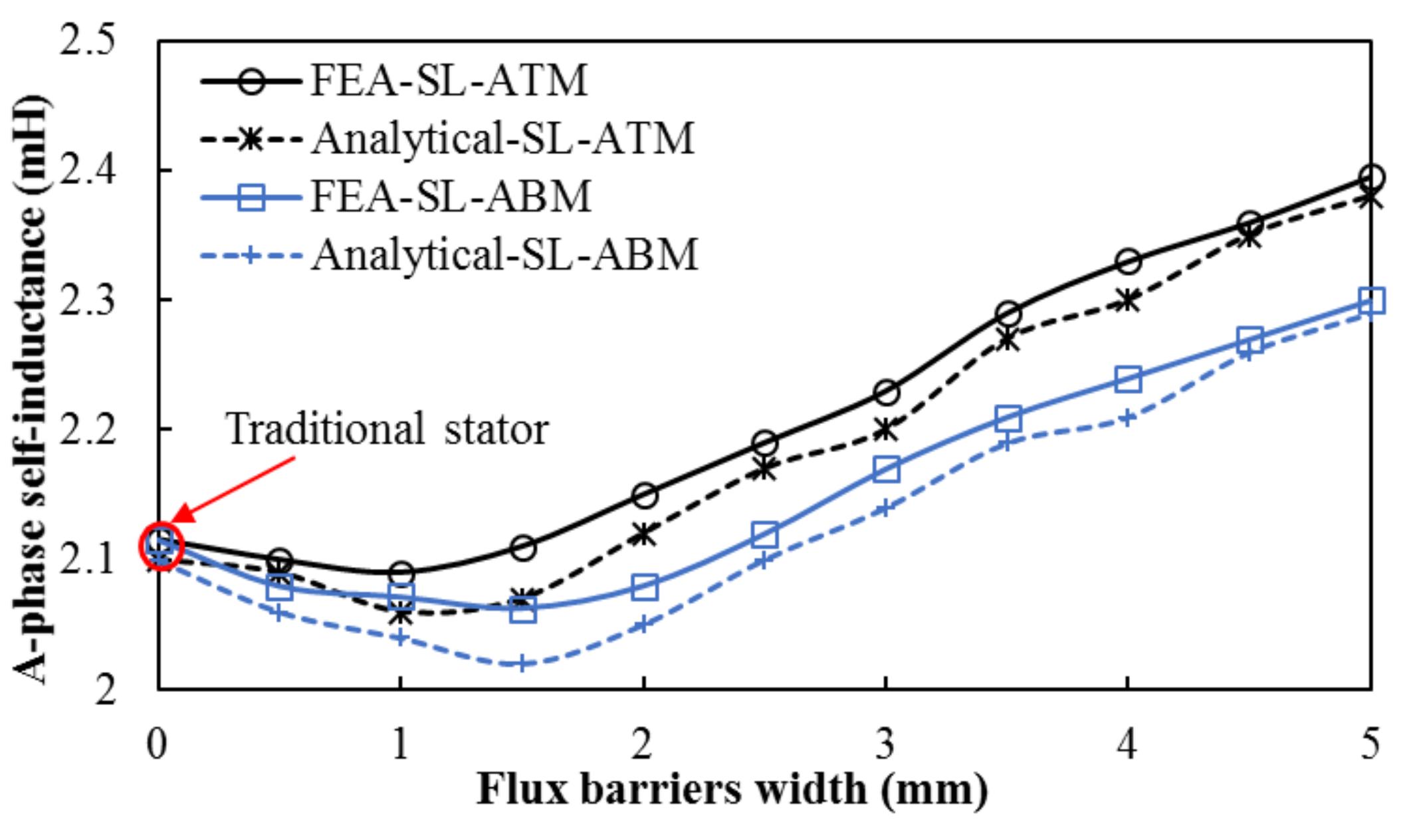
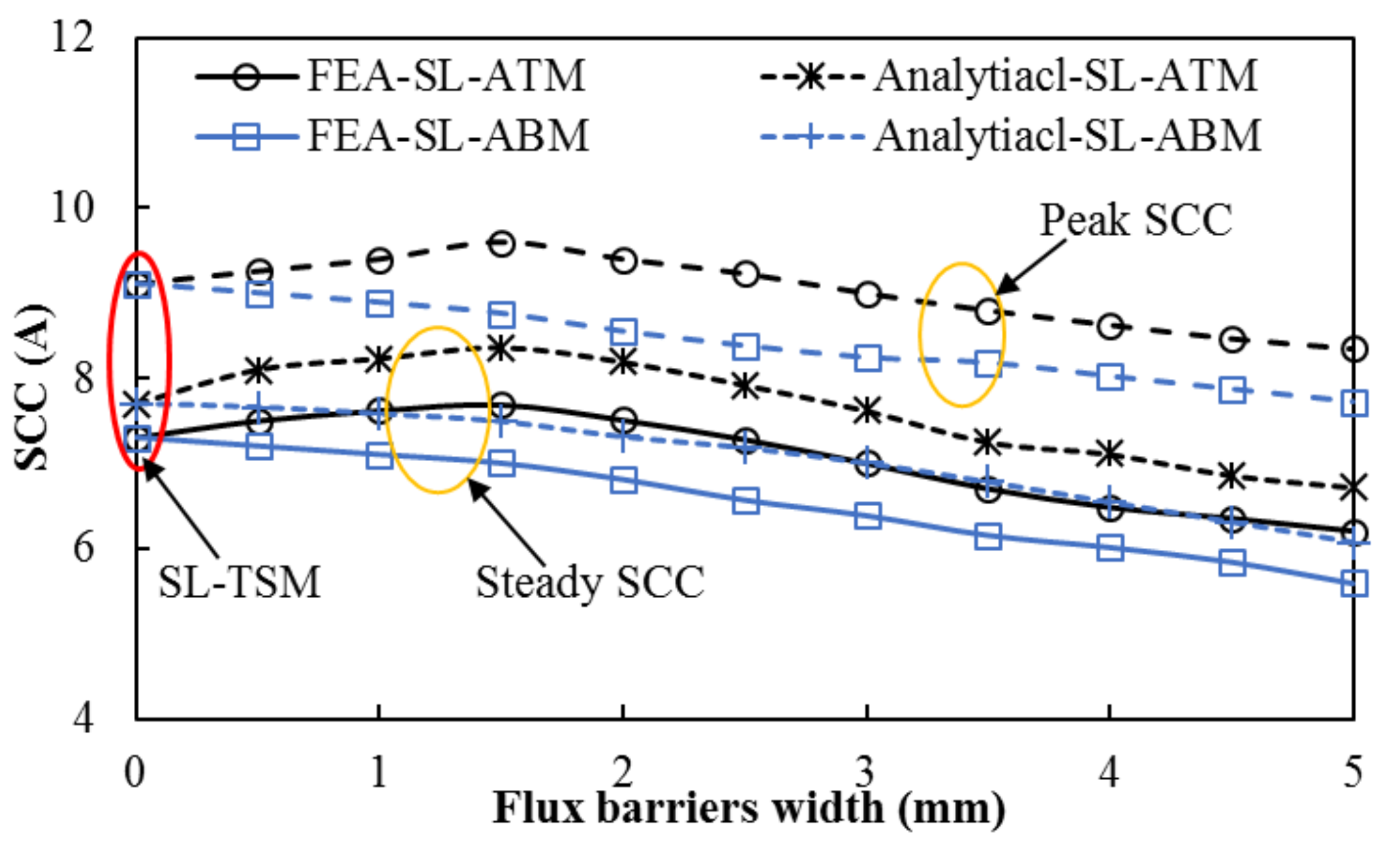
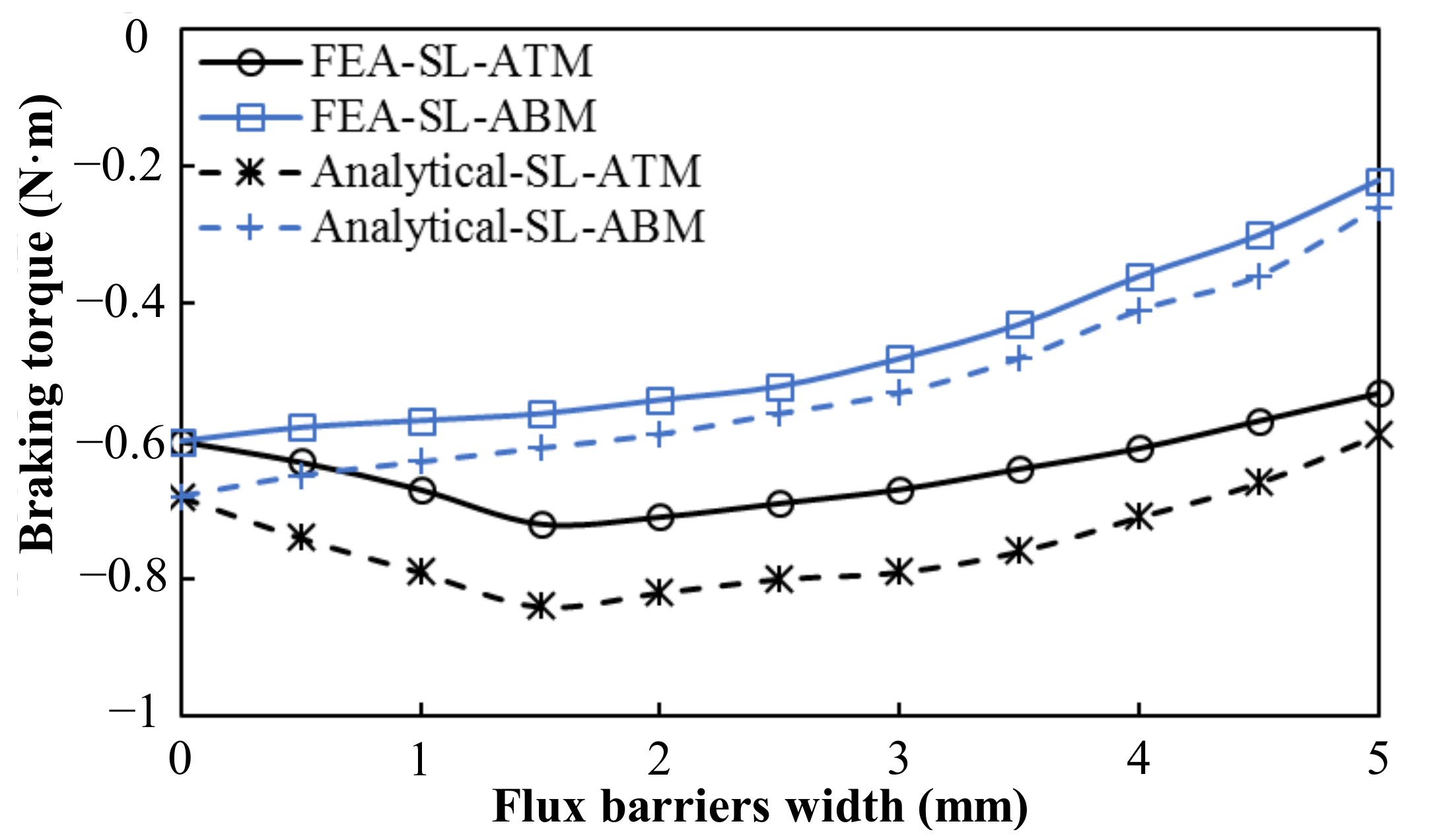

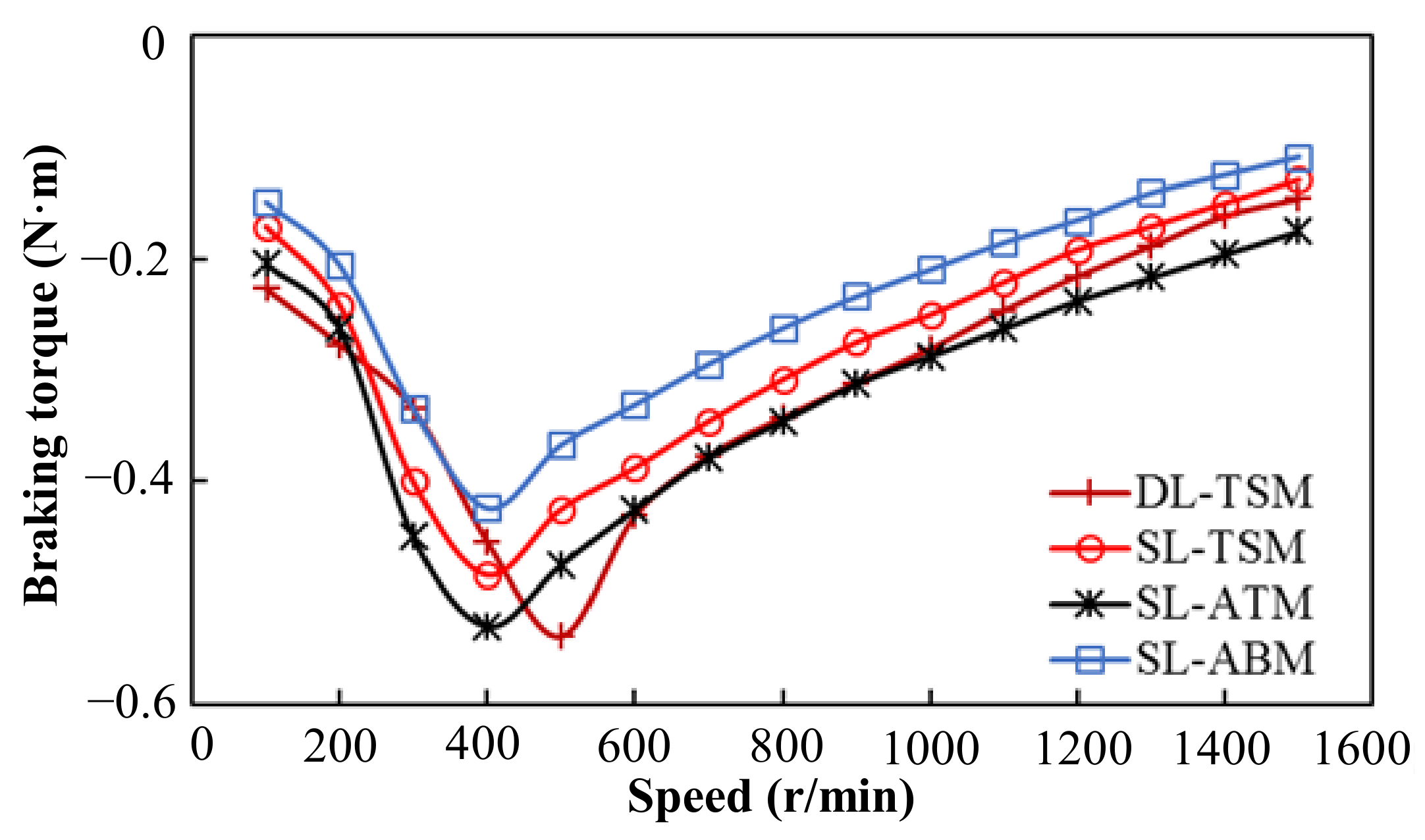
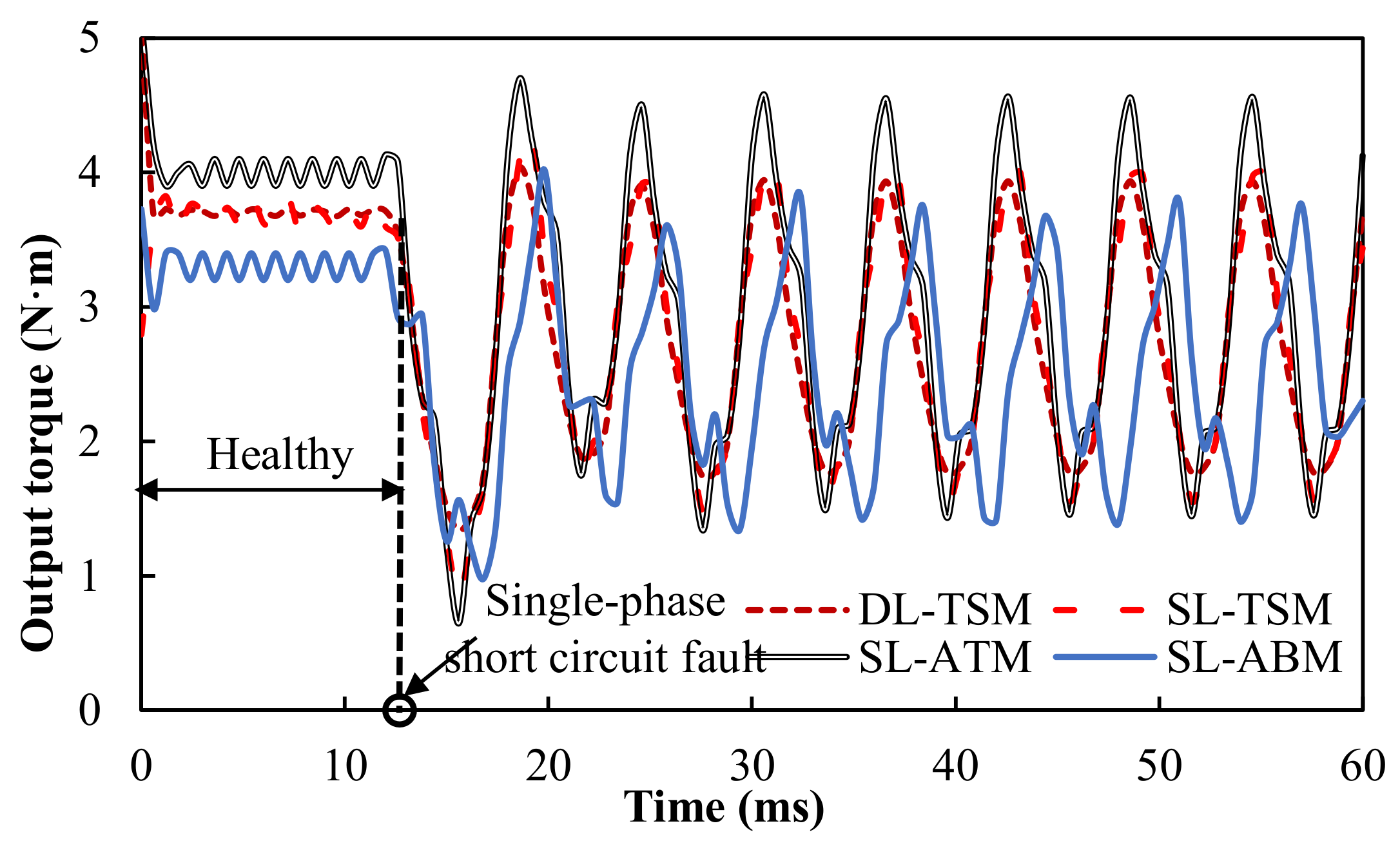
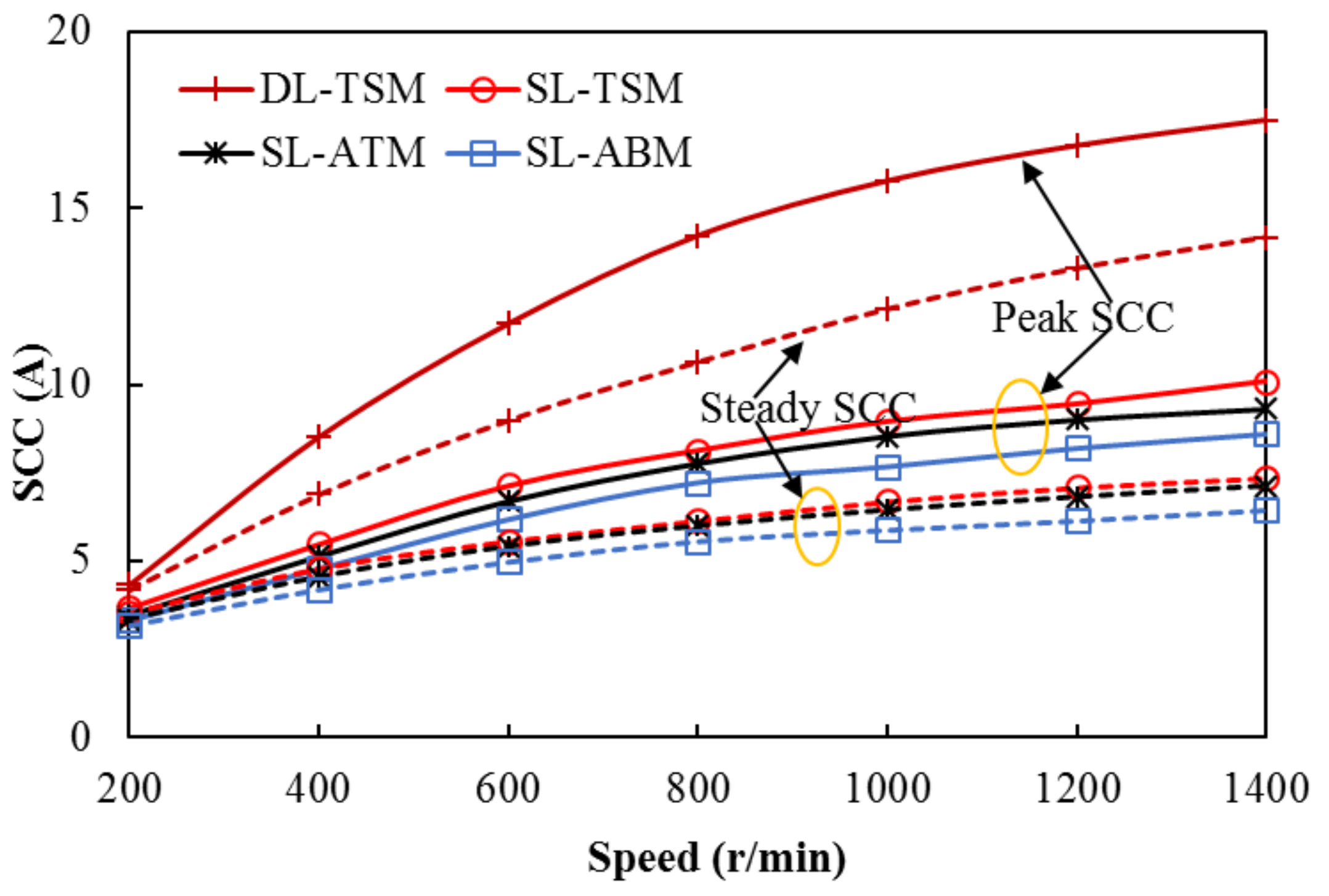
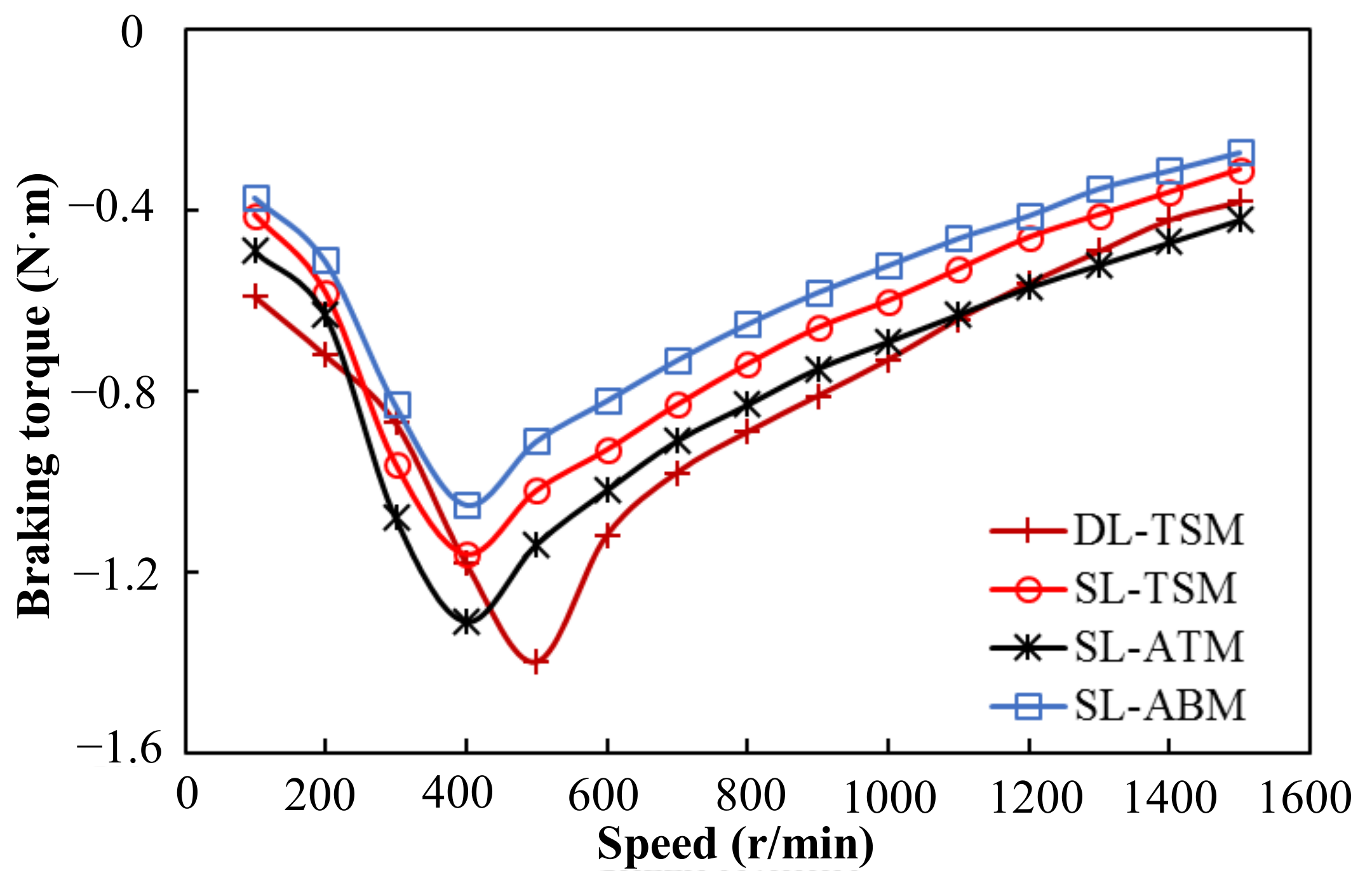

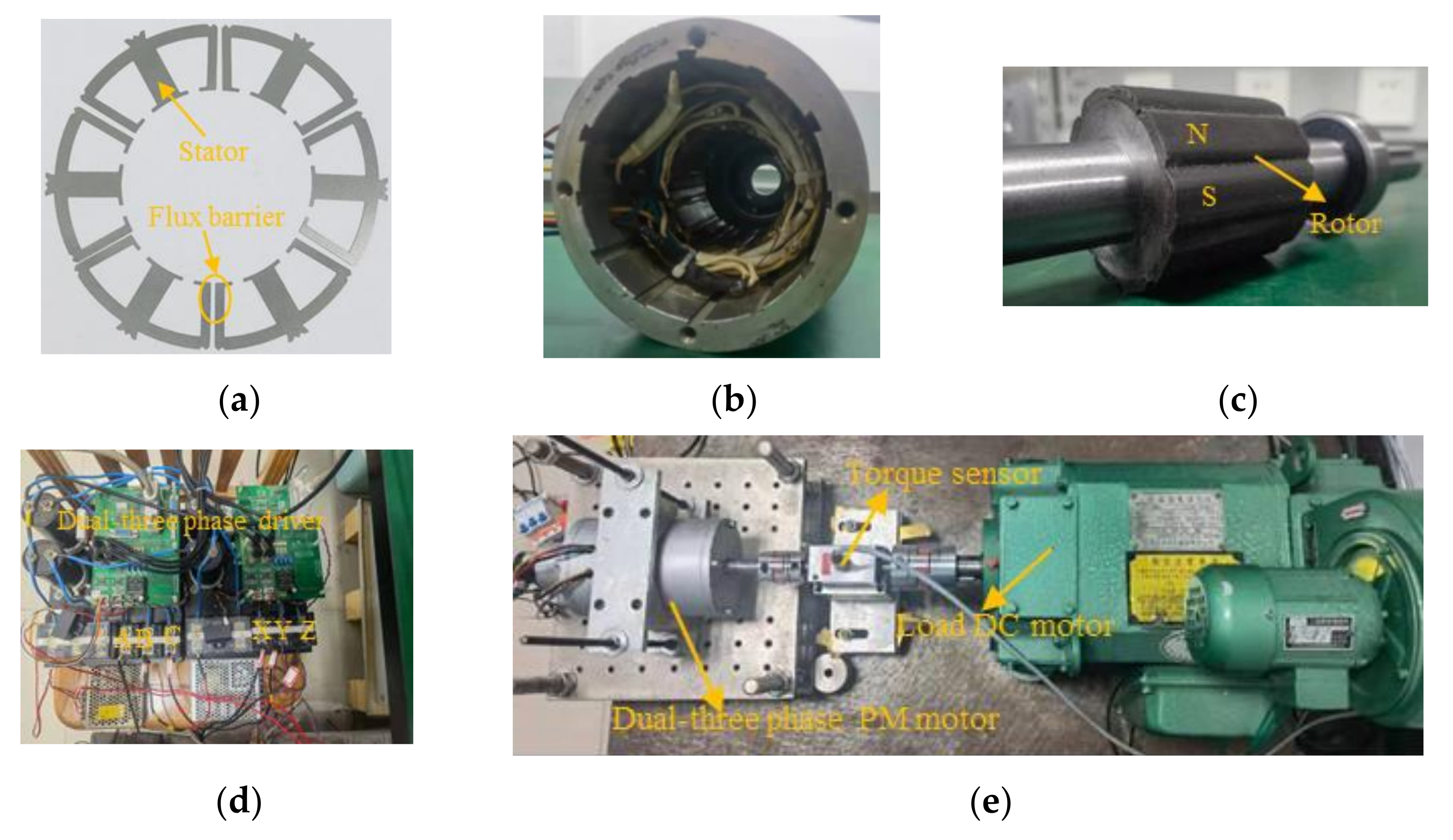

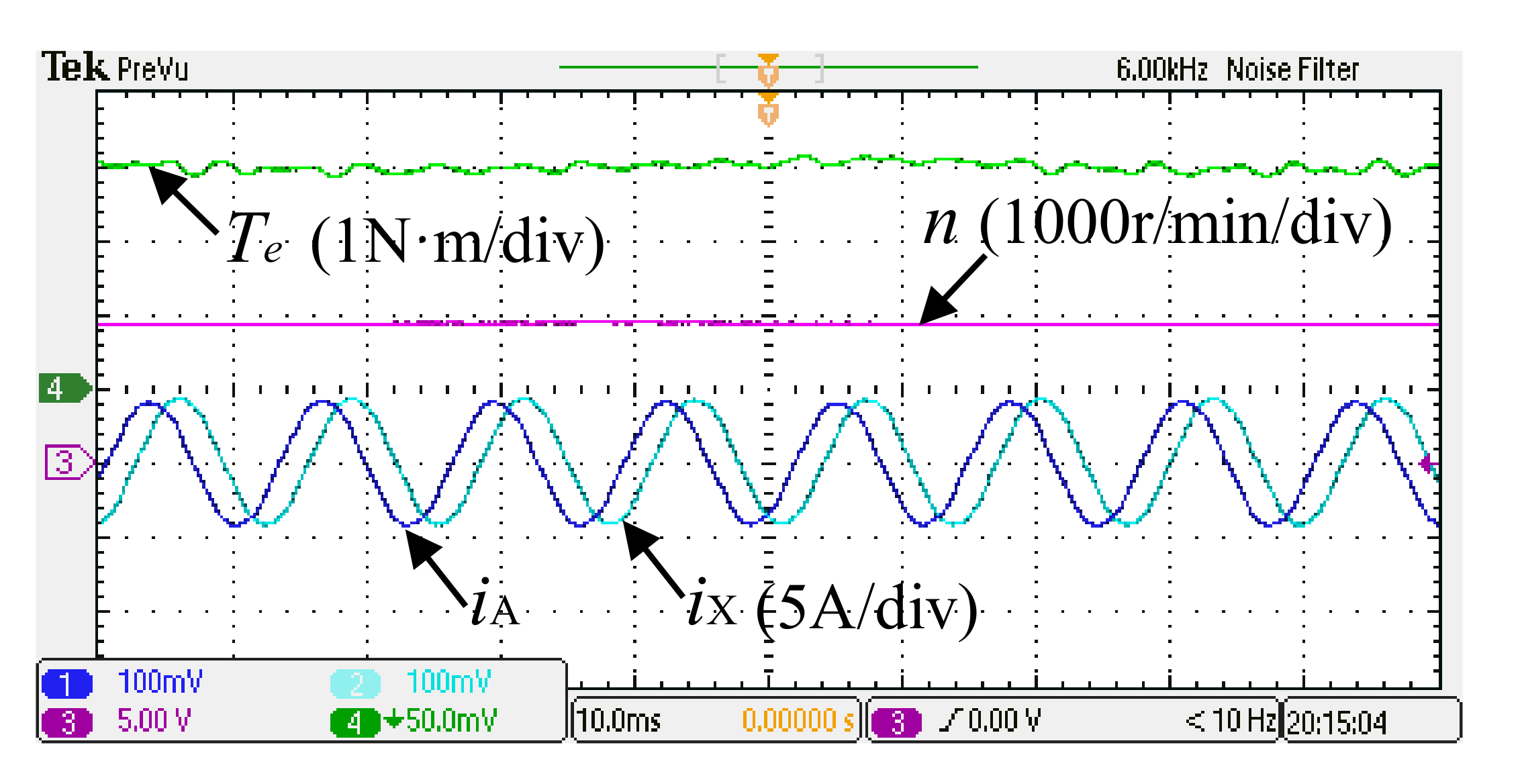

| Parameter | Value | Parameter | Value |
|---|---|---|---|
| Stator slot number | 12 | Stack length (mm) | 50 |
| Rotor pole number | 10 | Air-gap length (mm) | 1 |
| Rated speed (r/min) | 1000 | Rotor outer radius (mm) | 25 |
| Rated torque (N·m) | 4 | Rotor inner radius (mm) | 15 |
| Stator outer radius (mm) | 45 | Magnet thickness (mm) | 3 |
| Stator inner radius (mm) | 26 | Flux barrier width (mm) | 2.5 |
| Tooth width (mm) | 6 | NdFeB 35 remanence (T) | 1.2 |
| Yoke thickness (mm) | 3 | Number of turns/phase | 80 |
| Machine Type | kd | kp | kw = kd·kp |
|---|---|---|---|
| DL-TSM | 1 | 0.966 | |
| SL-TSM | 1 | 0.966 | |
| SL-ATM | 1 | 1 | |
| SL-ABM | 1 | 0.928 |
| Machine Type | LA (mH) | Machine Type | LA (mH) |
|---|---|---|---|
| DL-TSM | 1.08 | SL-TSM | 2.14 |
| SL-ATM | 2.19 | SL-ABM | 2.12 |
| Machine Type | Output Torque (N·m) | Torque Ripple (%) | Peak SCC (A) | Steady SCC (A) | Braking Torque (N·m) |
|---|---|---|---|---|---|
| DL-TSM | 3.7/2.6 | 2.2/113.3 | 18.3 | 14.6 | −0.3 |
| SL-TSM | 3.7/2.8 | 2.8/121.6 | 9.4 | 7.9 | −0.26 |
| SL-ATM | 4.1/3.2 | 4.6/137.6 | 10.2 | 8.5 | −0.31 |
| SL-ABM | 3.3/2.4 | 4.52/122.2 | 8.3 | 7.2 | −0.22 |
| Machine Type | Output Torque (N·m) | Torque Ripple (%) | Peak SCC (A) | Steady SCC (A) | Braking Torque (N·m) |
|---|---|---|---|---|---|
| DL-TSM | 3.7/0.83 | 2.2/24.6 | 18.3 | 14.6 | −0.82 |
| SL-TSM | 3.7/1.1 | 2.8/36.5 | 9.4 | 7.9 | −0.64 |
| SL-ATM | 4.1/1.2 | 4.6/39.2 | 10.2 | 8.5 | −0.77 |
| SL-ABM | 3.3/0.95 | 4.52/41.5 | 8.3 | 7.2 | −0.52 |
Publisher’s Note: MDPI stays neutral with regard to jurisdictional claims in published maps and institutional affiliations. |
© 2022 by the authors. Licensee MDPI, Basel, Switzerland. This article is an open access article distributed under the terms and conditions of the Creative Commons Attribution (CC BY) license (https://creativecommons.org/licenses/by/4.0/).
Share and Cite
Liu, L.; Wang, K.; Guo, L.; Li, J. Effect of Flux Barriers on Short-Circuit Current and Braking Torque in Dual Three-Phase PM Machine. Machines 2022, 10, 611. https://doi.org/10.3390/machines10080611
Liu L, Wang K, Guo L, Li J. Effect of Flux Barriers on Short-Circuit Current and Braking Torque in Dual Three-Phase PM Machine. Machines. 2022; 10(8):611. https://doi.org/10.3390/machines10080611
Chicago/Turabian StyleLiu, Lin, Kai Wang, Lingling Guo, and Jian Li. 2022. "Effect of Flux Barriers on Short-Circuit Current and Braking Torque in Dual Three-Phase PM Machine" Machines 10, no. 8: 611. https://doi.org/10.3390/machines10080611
APA StyleLiu, L., Wang, K., Guo, L., & Li, J. (2022). Effect of Flux Barriers on Short-Circuit Current and Braking Torque in Dual Three-Phase PM Machine. Machines, 10(8), 611. https://doi.org/10.3390/machines10080611






